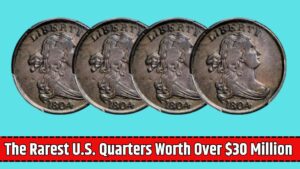The 1959-D Jefferson Nickel might look like any other coin at first glance, but it has a fascinating story and surprising value. Minted in Denver with over 160 million produced, it’s not just pocket change—it’s a piece of history.
Some coins stand out for their minting errors, special designations, or near-perfect condition, making them highly sought after by collectors. Let’s explore what makes this nickel so special and valuable.
A Quick Look at the Jefferson Nickel
The Jefferson Nickel series, introduced in 1938, replaced the Buffalo Nickel. Designed by Felix Schlag, it features:
- Obverse: A profile of Thomas Jefferson.
- Reverse: Monticello, Jefferson’s famous Virginia estate.
The 1959-D nickel is part of this long-running series. While most of these coins are common, certain features—like minting errors and the “Full Steps” designation—make some nickels worth hundreds or even thousands of dollars.
Factors That Affect the Value of the 1959-D Jefferson Nickel
High Grades and the Sheldon Scale
Coins are graded using the Sheldon Scale, which ranges from P-1 (Poor) to MS-70 (Mint State). The higher the grade, the better the condition—and the more valuable the coin.
For the 1959-D Jefferson Nickel, grades like MS-66 or MS-67 can fetch hundreds or even thousands of dollars. Why? These coins are rare and free of scratches, with sharp details that collectors love.
Mint Errors
Errors during the minting process can make coins rare and valuable. For the 1959-D nickel, look for:
- Die Cracks: Thin raised lines caused by damage to the die.
- Double Die Errors: Design elements like text appear doubled due to a misaligned strike.
- Off-Center Strikes: Coins with uneven designs because they weren’t struck correctly.
These errors can make the coin worth hundreds—or even thousands—depending on the type and its condition.
Full Steps Designation
The “Full Steps” (FS) designation is a big deal for Jefferson Nickels. To qualify, the steps on Monticello (on the reverse side) must be:
- Free of marks.
- Fully detailed with all six steps visible.
Full Steps nickels are much rarer than regular ones and are highly valued by collectors. For example, a 1959-D nickel with Full Steps in a high grade can sell for over $1,000.
How Much is the 1959-D Jefferson Nickel Worth?
Here’s a breakdown of its value based on grade and features:
| Grade | Approx. Value | Full Steps | Mint Errors |
|---|---|---|---|
| MS-63 | $10–$15 | N/A | N/A |
| MS-65 | $25–$40 | $100–$150 | $300–$500 |
| MS-67 | $150–$300 | $500–$1,000 | $2,000–$4,000 |
High-grade coins with Full Steps or minting errors can easily reach the thousands, so it’s worth taking a closer look at your coins!
Tips for Collectors
- Look for Full Steps: Examine the reverse side of the coin for clear, complete steps on Monticello.
- Search for Errors: Die cracks, doubling, or off-center strikes can dramatically increase value.
- Keep Coins Safe: Use holders or capsules to protect your coins from scratches or discoloration.
- Consider Grading Services: Professional grading services like PCGS or NGC can certify your coin and give it an official grade.
- Stay Informed: Keep track of auction results and market trends to know your coin’s value.
The 1959-D Jefferson Nickel is more than just a coin—it’s a piece of American history. Collectors prize it for its design, rare minting errors, and the elusive Full Steps designation.
Coins in top condition or with unique features can be worth thousands of dollars. Whether you’re a seasoned collector or just starting out, this nickel is a fantastic addition to any collection.
Who knows? That coin sitting in your change jar might be worth a fortune!
















